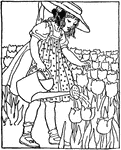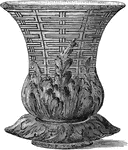
Hepatica
An illustration of liverwort (Hepatica): a, Thalloid stem with female branches; b, Thalloid stem with…
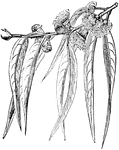
Blue Gum
A flowering branch of the Blue Gum Tree (Eucalyptus globulus), a tree in the Myrtaceae family of evergreen…

Strawberry Flagellum
"In botany, a runner; a weak, creeping shoot sent out from the bottom of the stem, and rooting and forming…

Blackberry Psyllid
The Blackberry Psyllid (Trioza tripunctata) is an insect that feeds on specific plants.

Wilhelma
The Wilhelma was originally a royal palace, mimicking Moorish architecture. After the second world war,…

Annual Spear Grass
Spear grass is a herbaceous grass often troublesome in gravel walks and on hard, dry soils. The general…
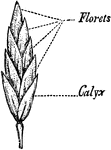
Annual Spear Grass
Spear grass is a herbaceous grass often troublesome in gravel walks and on hard, dry soils. The general…
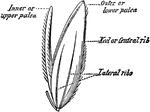
Annual Spear Grass
Spear grass is a herbaceous grass often troublesome in gravel walks and on hard, dry soils. The general…

Annual Spear Grass
Spear grass is a herbaceous grass often troublesome in gravel walks and on hard, dry soils. The general…

June Grass
June grass (Poa prstensis) is also known as Green Meadow grass, Common Spear Grass, Kentucky Blue grass.…

June Grass
June grass (Poa prstensis) is also known as Green Meadow grass, Common Spear Grass, Kentucky Blue grass.…

Indian Corn
Maize known as corn by most English-speakers, is a cereal grain domesticated in Mesoamerica and subsequently…
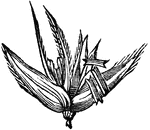
Indian Corn
Maize known as corn by most English-speakers, is a cereal grain domesticated in Mesoamerica and subsequently…

Indian Corn
Maize known as corn by most English-speakers, is a cereal grain domesticated in Mesoamerica and subsequently…

Indian Corn
Maize known as corn by most English-speakers, is a cereal grain domesticated in Mesoamerica and subsequently…

Red Clover
Red Clover (Trifolium pratense) is a species of clover. The Red Clover can readily be distinguished…

Red Clover
Red Clover (Trifolium pratense) is a species of clover. The Red Clover can readily be distinguished,…

Red Clover
Red Clover (Trifolium pratense) is a species of clover. The Red Clover can readily be distinguished…

White Clover
The White Clover ((Trifolium repens) stems are spreading, slender and creeping. The leaves are are inversely…

White Clover
The White Clover ((Trifolium repens) stems are spreading, slender and creeping. The leaves are are inversely…

Lucerne or Alfalfa Plant
Alfalfa or Lucerne (Medicago sativa) is a flowering plant in the pea family Fabaceae cultivated as an…

Lucerne or Alfalfa Plant
Alfalfa or Lucerne (Medicago sativa) is a flowering plant in the pea family Fabaceae cultivated as an…
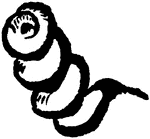
Lucerne or Alfalfa Plant
Alfalfa or Lucerne (Medicago sativa) is a flowering plant in the pea family Fabaceae cultivated as an…

Sainfoin
Sainfion (Hedysarum onobrychis), a hay, is a leguminous plant with many straggling, tapering, smooth,…
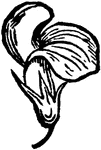
Sainfoin
Sainfion (Hedysarum onobrychis), a hay, is a leguminous plant with many straggling, tapering, smooth,…

Sainfoin
Sainfion (Hedysarum onobrychis), a hay, is a leguminous plant with many straggling, tapering, smooth,…
Timothy Grass
Timothy Grass is commonly grown for cattle feed and, in particular, as hay for horses. It is relatively…
Timothy Grass
Timothy Grass is commonly grown for cattle feed and, in particular, as hay for horses. It is relatively…

Pecopteris Tree Fern
Pecopteris, frond of an ancient tree fern, was a form genus of leaves from several unrelated plant groups…

Marine Isopod
The marine isopod or sand flea (Caprella) is an omnivorous feeder that eats detritus, one-celled plants,…

Scale Insects
The scale insects are small insects of the order Hemiptera, generally classified as the superfamily…

Scale Insects
The scale insects are small insects of the order Hemiptera, generally classified as the superfamily…

Scale Insects
The scale insects are small insects of the order Hemiptera, generally classified as the superfamily…

Scale Insects
The scale insects are small insects of the order Hemiptera, generally classified as the superfamily…
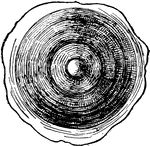
Scale Insects
The scale insects are small insects of the order Hemiptera, generally classified as the superfamily…
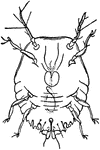
Scale Insects
The scale insects are small insects of the order Hemiptera, generally classified as the superfamily…

Scale Insects
The scale insects are small insects of the order Hemiptera, generally classified as the superfamily…

Sea Milkwort
"Flowering Branch of Glaux maritima. GLAUX. A primulaceous genus of plants, consisting of a single species,…

Gloriosa
"Flower of Gloriosa superba. GLORIOSA. A genus of tuberous-rooted liliaceaous plants, with opposite…

Grass Flower
"Graminae. Flower of a Grass, the glumes are removed. GRAMINAE. In botany, the largest order among endogenous…
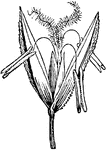
Grass Flower
"Graminae. Flower of a Grass. GRAMINAE. In botany, the largest order among endogenous plants except…
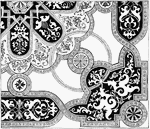
Table Cloth
This table cloth is made with damask, a weaving technique. It is woven in an arabesque pattern which…
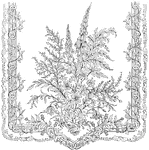
Lace Scarf
This lace scarf is ornamented with British plants and flowers in needlework. It was designed in 1851.

Wood Carving
This wood carving represents spring which is symbolized by forty-seven varieties of plants.

Butter Dish
This butter dish is also known as a butter cooler. It has a cover and is designed in a trellis work…

Perfume Vase
This perfume vase is embossed with a design of oak leaves, acorns, aqueous plants, and fish. The lid…

Glossy Abelia
"Ornamental plants, cultivated chiefly for their handsome flowers. The Abelias are small or medium-sized…
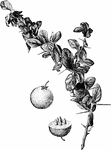
Aberia Caffra
"Aberia Caffra, Hook. f. & Harv. Fig. 59. Thorny, glabrous: lvs. obovate, obtuse, cuneate at base, entire:fls.…

